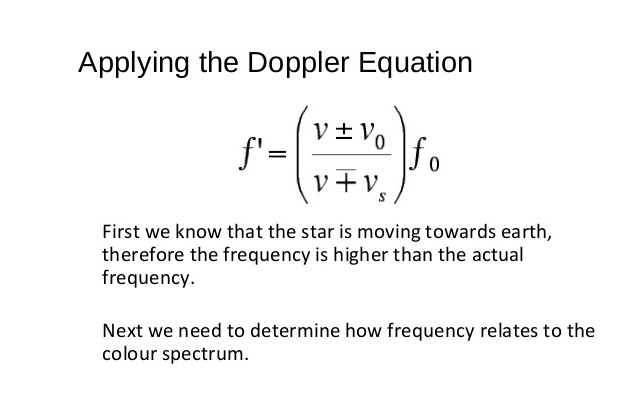

The note she plays has a frequency of 300 Hz but you hear a note with a frequency of 280 Hz. A trumpeter plays her trumpet while in a car. Assume that the emitted frequency is 400 Hz. Find the change in the frequency of a siren from a train that is moving towards you at 50 ms -1. A galaxy is moving away from the Earth at 26000 kms -1.Ĭalculate the wavelength and frequency change of a 650 nm line in its spectrum. L' = l - vt and so the wavelength change is Dl = l - l' = vt but t = l/c and so:ġ. In a time t the wave travels from S to O, a distance l, and the source travels from S to S', a distance vt. The source emits waves of wavelength l, frequency f and velocity c. The case for a moving observer is similar especially if the velocity of the source is small compared with the velocity of the wave.Ĭonsider a source S moving with velocity v towards an observer O, exactly one wavelength away. We will consider one case only - that of a moving source. Proof of the formula for the Doppler effect You can see that the wavelengths on the right are closer together than those on the left if the source is approaching an observer the wavelength will be reduced while if it is moving away they will be increased. If it is emitting a wave then the three circles represent the positions of the waves emitted at points 1, 2 and 3 some time after the source passed position 3. Initially it is at position 1 and some time later at positions 2 and 3. Consider a source S moving from left to right. We will now look at the Doppler effect in wave motion. The rate at which the chocolates were put on the belt corresponds to the original frequency of the source, the velocity of the belt corresponds to the wave velocity (which is constant and unaffected by the motion of either the source or the observer) and the rate at which you receive them corresponds to the observed frequency. Now to compare this with the transmission and reception of a wave. You will also receive chocolates faster if you walk towards the other end of the conveyor belt collecting chocolates as you go. You can see that you will receive the chocolates at a faster rate because after putting one chocolate on the belt your partner walks after it and when the next chocolate is put on the belt it will be closer to the first chocolate than if he or she had not moved.

Now the other person starts to walk slowly towards you alongside the conveyor belt, still putting chocolates on at the original constant rate. The chocolates therefore reach you at the same steady rate at which they were put on the belt. At the other end of the belt another person puts the chocolates on the belt at a steady rate. We can think of a simple analogy to this by imagining that we work in a chocolate factory - packing chocolates that come to you down a steadily moving conveyor belt. (g) measurement of the speed of the blood in a vein or artery (f) Doppler broadening of spectral lines in high temperature plasmas (d) the variation in the frequency of the light from spectroscopic binaries (c) the shift of the frequency of the light from the two sides of the solar disc due to the Sun's rotation (b) the change in pitch of a train hooter or whistle as it passes through a station (a) change in the pitch of a buzzer when it is whirled around your head

The effect can be also be observed in the following uses and applications of the Doppler effect Galaxies have their light shifted towards the red due to their speed of recession and when we receive the light at the Earth we describe it as Red Shifted. One of the most important applications of the Doppler effect is in the study of the expansion of the Universe. In fact his aim had been to disprove Doppler's theory!ĭoppler effect shown in the sound waves emitted by a fast moving jet

They played in an open railway carriage while the carriage travelled across the Dutch countryside and observers on the ground heard a change of pitch as the carriage passed them. In 1845 the Dutch scientist Buys Ballot tested Doppler’s theory for sound waves by using a group of trumpeters playing a calibrated note on a train on the Utrecht-Amsterdam line. Looking at a duck swimming in a pond would show you that the waves it generates in the direction it is swimming are bunched while those behind it are spread out. These effects were first explained by Doppler in 1842 as a bunching up and a spreading out of waves. The Doppler effect is the apparent change of frequency and wavelength when a source of waves and an observer move relative to each other.


 0 kommentar(er)
0 kommentar(er)
